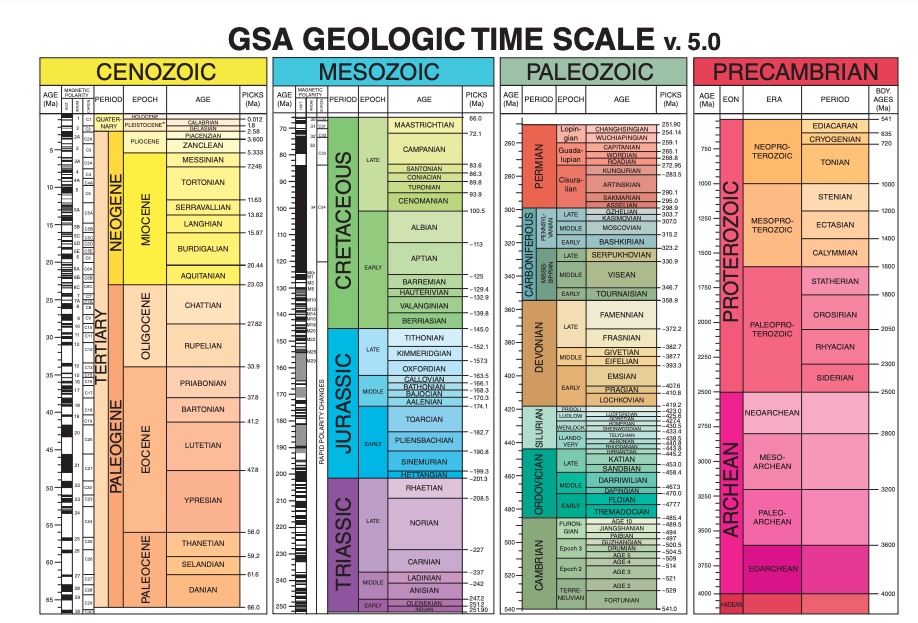The Stone Pavilion Project
Time Machine


Geological Time Scale
The geological time scale spans nearly 4.6 billion years of Earth history. It is organized hierarchically with the largest units --Eons-- divided into Eras divided into Periods divided into Epochs divided into Ages. For each Period of time, there is a tangible companion unit called a System that contains all rocks created during that period of time. For example, the Crab Orchard Stone from a ranch in Tennessee (#40) is part of the Pennsylvanian System because it was deposited during the Pennsylvanian Period.
Link here for the full sized Geological Time Scale used by the Geological Society of America.

Oldest and Youngest Specimens
Approximately half of Earth's 4.6 billion-year-long history is exhibited on the wall of stones.
The oldest specimen (#32) is an ex situ boulder from the Canadian shield that was carried southward by the Laurentide Ice Sheet and collected from somewhere in North Dakota (see photo to right). Staff from that state's geological survey suggests suggests it is likely late Archaean (2.7 Ga) or possibly early Proterozoic (1.8 Ga) in age. A different specimen from Michigan's Upper Peninsula (#20) is likely the oldest in situ specimen in the exhibit. It's state survey staff estimated its age as also likely Late Archean or Early Proterozoic.
The youngest specimen (#29) is probably the one from New Mexico (see photo to right). This is the surface of a lava flow. The state survey suggests it may be from the Carrizoza Plain which erupted about 5,000 years ago during the middle Holocene.
Time Line
This part of the site is under construction. The units of the time line are Eons, arranged from oldest to youngest. One billion years ago is abbreviated 1 Ga.
-
-
HADEAN (4.6 to 4.0 Ga). We have no specimens of this age because there were no rocks on earth this time. The planet was molten. However, nearly all the materials of Earth were present then, much of it having been recycled many times, especially the volatiles.
-
ARCHEAN (4.0 to 2.5 Ga). The Archean Eon is earth's strangest, the time when much of the basement rock of North America, it's continental craton, was being formed. Much of the upper Great Lakes region and the adjacent Canadian Shield are of Archaean age, and our specimens from North Dakota (#32) and Michigan's Upper Peninsula (#20) day date to this eon.
-
PROTEROZOIC (2.5 to 0.5 Ga). Many of our rocks are Proterozoic, most notably the early Proterozoic ( 1.76-1.63 Ga) Sioux Quartzite (#14) from Kansas, and the Baraboo Quartzite from Wisconsin (#47), both of which are metamorphosed quartz-rich sandstones. Other Proterozoic rocks include the Pikes Peak Granite (#10), a granite intrusion slightly older than 1 billion years, and an even older pegmatite from the Black Hills of South Dakota dating to 1.7 Ga.
-
PHANEROZOIC (0.5 to 0 Ga). The vast bulk of our specimen stones are from Earth's latest eon, the Phanerozoic, the time of visible life. They can be arranged by the familiar Period Names: For the Paleozoic these are: Cambrian, Ordovician, Silurian, Devonian, Mississippian, Pennsylvanian, Permian. For the Mesozoic, these are Triassic, Jurassic, Cretaceous. For the Cenozoic, these are Paleogene, Neogene, Quaternary.
-
Paleozoic Era: This is the longest and oldest Era of the Proterozoic Eon. In North America, this was a time of vast epicontinental seas that deposited sedimentary rocks over much of what is now the interior U.S. The ancient coral reef deposit from Iowa (#13), a fossil hash from Kentucky (#15) and marine sandstones composed of fossil particles from Arkansas (#3) and Indiana (#12) and Illinois (#11) date to this era and its shallow tropical seas. The Oriskany Sandstone from Pennsylvania (#36) was so widespread as a beach deposit that it's extends to nearly a dozen adjacent states. The Paleozoic was also a time of great mountain building in the Appalachians, with a variety of igneous and metamorphic rocks exemplified by the Brandywine Blue Gneiss from Delaware (#7), vein quartz from eastern Alabama (#1) at the southern limit of the range, and granites from Georgia (#9), Vermont (#43) and Maine (#17).
Mesozoic Era: The middle era of the Phanerozoic Eon is appropriately titled the Mesozoic. This was a time of especially active mountain building in the western U.S., as indicated by Montana's silver ore (#24). Along the east coast, the dominant theme was continental rifting, vulcanism, and sedimentation in rift basins as the earliest Atlantic was being formed. Connecticut's barite breccia (#6) and New Jersey's red sandstone (#28) offer good examples. In the southwest were vast dry deserts in what is now the southwestern United States as indicated by the windblown Aztec Sandstone and the desert red-rock of Arizona's petrified forest (#2).
Cenozoic Era: The last Era of the Phanerozoic Eon is the Cenozoic, which follows the dinosaur (non-avian) extinction about 66 million years ago (0.0066 Ga). Generally, this was a time of cooling climates that culminated in vast ice sheets and the transport of boulders as far south as Kansas (#14). On the high plains, vast sheets of of sandstone and siltstone were deposited as extensive formations, best shown by the Oglalla Group of Nebraska (#25). Recent vulcanism is another theme, notably the lavas of the Snake River Plain in Idaho (#10), and in California (#4), New Mexico (#29), and Hawaii (#50).